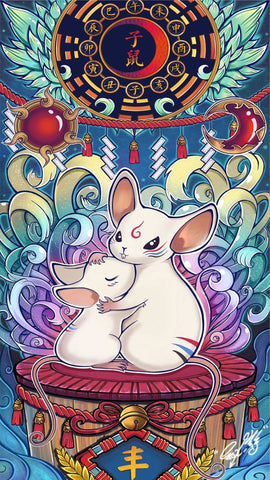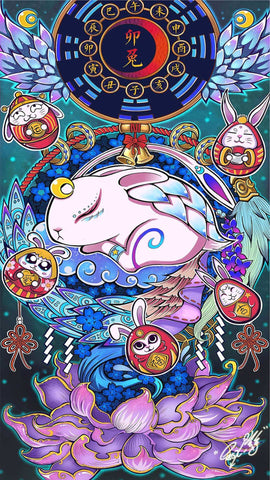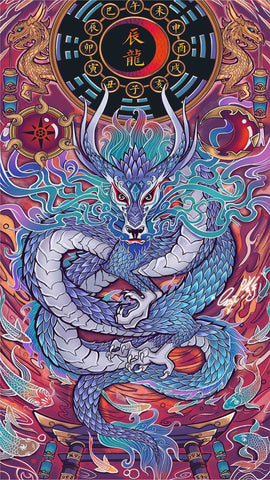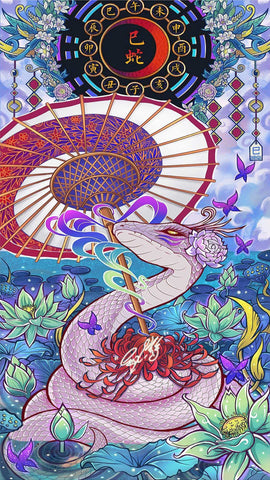Rat
The rat ranks the first among the twelve animals in Chinese zodiac. It is associated with the Zi in the Twelve Earthly Branches and the hours form 11:00 pm to 1:00 am. This is the time when the rat goes out most frequently, covered by the night. Therefore it is also referred to as "Rat of Zi". Rats are fertile, and the ancient people wished for a thriving family with lost of offspring to carry down the line. So the folks consecrated "the God of Zi (rat)".
The rat is considered to be smart and quick in mind, and in some places, a sign of wealth to worship.

OX
Ox ranks the second among the twelve animals in Chinese zodiac. It is associated with Chou in the Twelve Earthly Branches and the hours from 1:00 am to 3:00 am. This is the time when the ox has eaten enough grass and is enjoying its rumination. Therefore it is also referred to as "Ox of Chou". Chinese people have deep affection to the ox, for it has worked for the farmers for a long time. People attach merits suck as honesty, diligence and selflessness to it. Lu Xun once marked his own aspiration as "Head bowed, like a willing ox I serve the children".
In the ancient times, oxen were the most sacred sacrifices, only used during the emperor’s rites to pay tribute to the society, heaven and earth. In the Spring and Autumn Period and the Warring States Period, on the meetings of the dukes and princes, the emperor cut the ox ear and rub the blood into his own mouth. Aosemise, a genesis mythology of Hani Ethnic Group, recorded a story about the parts of an ox turning into all the things in nature. The Han people worshiped the ox king, and there is an ox king temple in Chengdu City, Sichuan Province, built in the seventh year of the Emperor Kangxi of the Qing Dynasty. Horns of buffalo, cattle and yak were the most commonly seen decorations on the gate. People of Zang Ethnic Group often hanged horns on the gate to show their hunting skills, and used horns to decorate their clothing.

Tiger
Tiger ranks the third among the twelve animals in Chinese zodiac. It is associated with Yin in the Twelve Earthly Branches and the hours from 3:00 am to 5 am. This is the time when the tigers are the most excited and ferocious, roaring in the forest. Therefore it is also referred to as "Tiger of Yin". Throughout Chinese history, the tiger is thought to be "the king of the woods". It incited a sense of both awe and worship for its power and ferocity. Tiger is one of the four guardian gods of the Taoism. "Chapter of Propriety" Part one in the The Book of Rites records, "(Banner with the) Red Bird should be in the front, that with the Black Tortoise behind, that with the Azure Dragon on the left, and that with the White Tiger on the right". The Tujia Ethnic Group worshiped white tigers as the god of family.
In all kinds of rituals and festival activities, many issues about tigers relate with witchcraft. In Huangling County of Shangxi Province, the groom’s family will prepare four pairs of steamed buns in the shape of tiger and rabbit, filled with walnuts, dates and coins, named "wedding huamo", featuring a bridal couple. When the groom pick up his bride on the wedding day, two pairs of the huamo will be presented to the bride’s family and broken apart in the public. If the walnut filling occurs first, the bridal couple’s first baby will be a boy; and the date filling, a girl. These wedding traditions and superstitions evolve into folk customs over time.

Rabbit
The rabbit ranks the fourth among the twelve animals in Chinese zodiac. It is associated with Mao in the Twelve Earthly Branches and the hours from 5:00 am to 7:00 am. At this the moon has not faded completely, and rabbit stands for the moon because there is said to be a Jade Rabbit living on the moon. Therefore it is also referred to as "Rabbit of Mao", And it is also the time when the rabbits come out of their holes and graze on dewe fresh grass. The rabbit is a tame creature representing loads of good wishes as one of Chinese zodiac. In the traditional sense, the idioms of rabbits are mostly negative, while new meanings are also given to the animal: vigorous like a rabbit; advance like a rabbit.
A beautiful story shared in Sichuan Basin tells a rabbit fairy stole the wine to cure her mother, whick led to a happy and wonderful marriage. A young man had a liquor workshop in the Sichuan Basin, and one night he ran into a snow-white rabbit trying to steal his medlar wine. He didn’t blame the rabbit, bur gave away the wine. A few days later a beautiful maiden came to his house with jar of wine for him. They fell in love with each other after and got married. The maiden turned out to be a rabbit who took on human form and fell in love with the man to pay a debt of gratitude for giving her the medlar wine the other day, which was for curing her mother.

Dragon
Dragon ranks the fifth among the twelve animals in Chinese zodiac. It is associated with Chen in the Twelve Earthly Branches and the hours from 7:00 am to 9:00 am. The legendary dragon is said to like to ride on the mists and clouds at sunrise. Therefore it is also referred to as "Dragon of Chen".
Dragon is the totem of China as well as its symbol. Chinese deem that dragon is the god-like beast standing for luck, which can also control rain and wind. In the Neolithic age 8,000 years ago, the ancient people worshiped the totem of dragon; up to now, people still use many phrases including the word "dragon" to describe good things in their lives, such as "dragon rising and tiger leaping" "the vigor of dragons and horses". Chinese call themselves proudly "Descendant of the Dragon". Thus dragon became a symbol of nation.
It is said that when Emperor Shun ruled in the ancient times, a man named Dong Fu was given a clan name "Huanglong" for his superb ability of taming dragons. In the Xia Dynasty, a man named Liu Lei was given a clan name "Yulong", also for skills in training dragons. According to these legends, fantasy stories about dragons dated from Yao, Shun and Yu Period. In the thousands of years, there was an evolutionary progress about the image of dragons: simple "original dragon" in the Neolithic age; mysterious "Kui dragon" in the Xia, Shang and Zhou Dynasties; rough and masculine "flying dragon" in the Spring and Autumn Periods, Warring State Period, the Qin and the Han Dynasties; both forceful and soft "moving dragon" in the Wei, Jin, Sui and Tang Dynasties; complicated and gorgeous "yellow dragon" in the Song, Yuna, Ming and Qing Dynasties; and the "luck dragon" symbolizing good fortune in the recent periods.

Snake
The snake ranks the sixth among the twelve animals in Chinese zodiac. It is associated with Si in the Twelve Earthly Branches and the hours from 9:00 am to 11 am. Art the time, the morning fog has gone, and the sun shines brightly. The snake hides inside of the grass to rest. Therefore it is also referred to as "Snake of Si".
The snake is one of the most ancient and vital animals in nature. It is a major feature of the totem of Han clan living in the middle and lower reaches of the Yangtze River. In some places, it is a taboo to call snake by its name. People refer to them as "the blue dragon" "the little dragon" or "the fairy", to avoid troubles from disrespect to the animal. People worship the snake and think they could bring people fortune.

HELLLOOO I LOVE THESE PICTURESS CAN I PLEASE HAVE THE ORIGNAL FILES OF THESE PICTURES I WANT TO PUT UP A POSTER OF ALL 12 IN MY ROOOM. PLEASEEEEEEEEE
Leave a comment